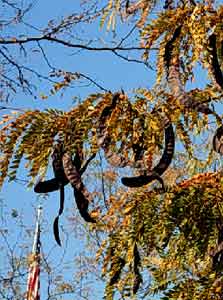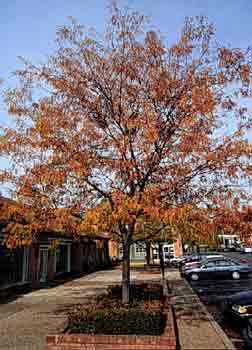 Honeylocust - Gleditsia triacanthos
Honeylocust - Gleditsia triacanthos
Pea Family (Fabaceae)
Honeylocust occurs most frequently in central and western Kentucky. Native trees have numerous thorns along the main stem and branches. Trees used in the landscape are thornless and often do not produce the characteristic long pods. It is common in old farms and pastures. The Kentucky champion tree is in Lewis County and is 80 feet tall.
Introduction: Once an excellent lawn tree, honeylocust has been greatly overused and has developed a number of disease and insect problems that have made it a short-lived tree in many areas. The beautiful, fine-textured tree offers light shade, allowing grass to grow up to its trunk. Its bright green leaves turn yellow in fall. The long thorns of the species are not present on var. inermis. Honeylocust is not a long-lived plant for landscapes in the southern U.S.
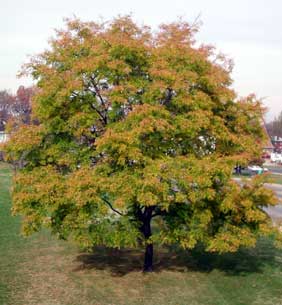 Culture: Honeylocust tolerates a wide range of conditions but performs best in full sun on limestone soils or in rich, moist bottom lands. It will tolerate high pH, drought and salt, but any stress will make it more susceptible to diseases and insects. The tree, which should be pruned in fall, is easy to transplant, although its coarse root system requires a larger than average root ball. Honeylocust is susceptible to a number of problems including leafhopper, cankers, flat-headed borers, mimosa webworm, spider mites, powdery mildew, rust and leaf spot. Honeylocust can be a short-lived tree in our area.
Culture: Honeylocust tolerates a wide range of conditions but performs best in full sun on limestone soils or in rich, moist bottom lands. It will tolerate high pH, drought and salt, but any stress will make it more susceptible to diseases and insects. The tree, which should be pruned in fall, is easy to transplant, although its coarse root system requires a larger than average root ball. Honeylocust is susceptible to a number of problems including leafhopper, cankers, flat-headed borers, mimosa webworm, spider mites, powdery mildew, rust and leaf spot. Honeylocust can be a short-lived tree in our area.
- Native habitat: Pennsylvania to Nebraska, south to Texas and Mississippi.
- Growth habit: Short trunk and an open, spreading crown; irregular silhouette.
- Tree size: Varies from 30 to 70 feet tall with a similar spread. It can reach a height of 100 feet or more in the wild.
- Flower and fruit: Greenish-yellow, perfect and imperfect flowers are borne on the same tree from May to June. Flowers are fragrant but not showy. Fruit is a reddish-brown to brown pod from 7 to 18 inches long and about an inch wide. It contains hard, oval seeds and is often irregularly twisted. There are cultivars that are fruitless.
- Leaf: Alternate, pinnately or bipinnately compound, 6 to 8 inches long with 20 to 30 leaflets. Leaves are bright green in summer; fall color is yellow. Leaves drop early in fall.
- Hardiness: Winter hardy to USDA Zone 4.
There are many selections of honeylocust. All are thornless and most will not produce fruit. Popular cultivars of honeylocust include:
- ‘Christie' - Vigorous growth and a symmetrical, full crown.
- ‘Emerald Kascade' - A thornless weeping form with dark emerald-green foliage.
- ‘Impcole' or Imperial® - Small, rounded form with spreading branches and the most compact of the popular honeylocust cultivars.
- ‘Moraine' - Seedless, vase-shaped cultivar with a rounded top and better resistance to webworm.
- ‘Shademaster' - Has upright ascending then spreading branches that result in an irregular, vase-shaped form. It does not produce pods.
- ‘Skyline' - Pyramidal form with ascending branches and bright golden yellow foliage in fall.
- ‘Sunburst' - New foliage is bright yellow and contrasts with dark yellow-green interior foliage. Irregular form.
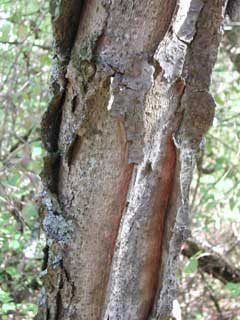 Additional information:
Additional information:Honeylocust has been used extensively as a street and shade tree. It transplants easily at large sizes and casts a light shade. It complements many architectural features in the landscape. However, it has been overplanted in many areas and many insect and disease pests attack honeylocust. It may be a short-lived species in our area.
Gleditsia triacanthos has sharp thorns up to a foot long on the trunk and main branches; var. inermis is a thornless form, but will develop thorns about 3 inches long when the tree is stressed. Seed pods are rather unsightly as they remain on the tree into fall. They also cause significant litter problems. Many cultivars of honeylocust will not produce fruit until the trees are older.
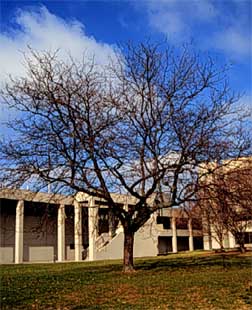 In Florida, honeylocust is sometimes called Confederate pintree, because its spines were used to pin together the tattered uniforms of soldiers during the Civil War. People in the southern mountains once used the thorns of honeylocust in carding wool, and to pin the mouths of wool sacks.
In Florida, honeylocust is sometimes called Confederate pintree, because its spines were used to pin together the tattered uniforms of soldiers during the Civil War. People in the southern mountains once used the thorns of honeylocust in carding wool, and to pin the mouths of wool sacks.
National champion trees are in Michigan (116 feet), Virginia (104 feet) and Pennsylvania (90) feet.


